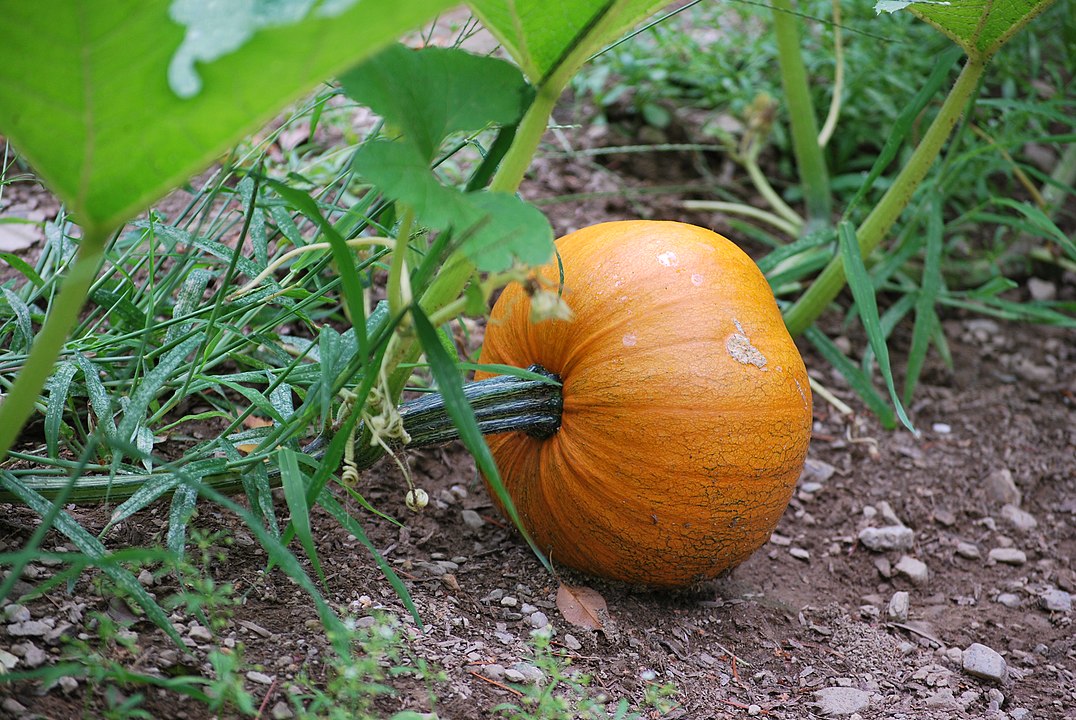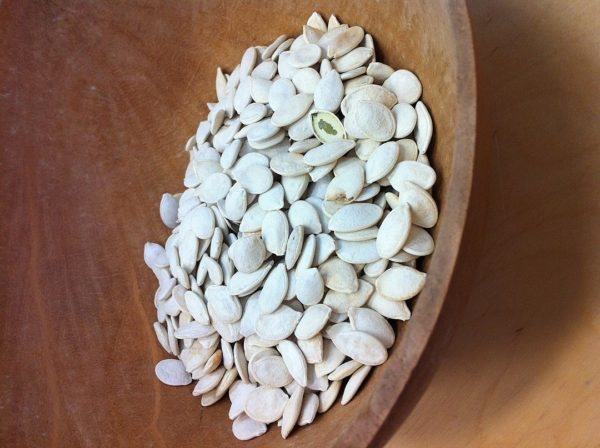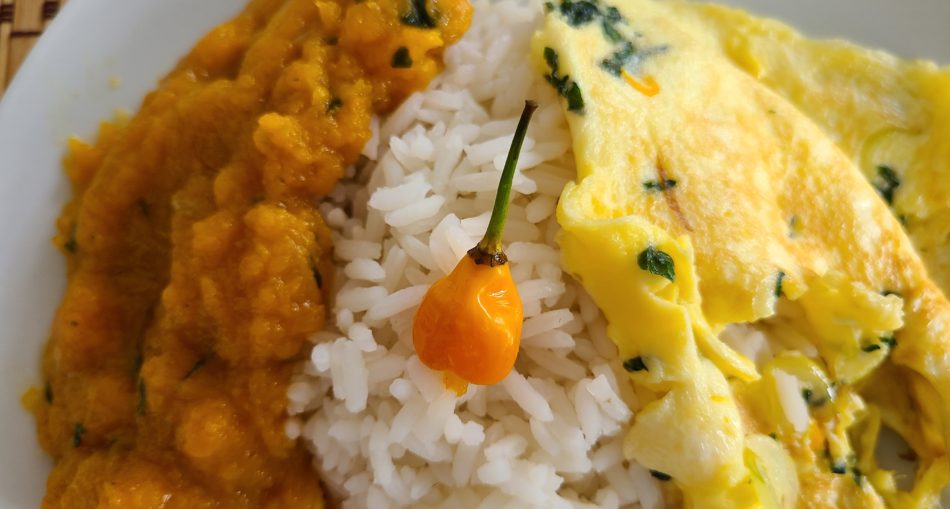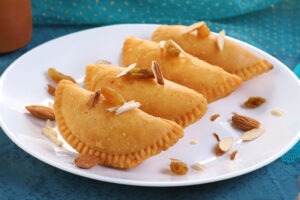It is a common saying in Guyana that “pumpkin makes your eyes bright.” Mothers tell it to their children and the children, when grown, tell it to their children. Having this statement in mind, the kids would eat it – though hesitantly; as for the adults they find pleasure in eating pumpkin, they eat it in a variety of ways.

Pumpkin – Photo by By Juliancolton – Own work, Public Domain, https://commons.wikimedia.org/w/index.php?curid=11162258
What is Pumpkin?
The pumpkin fruit is a cultivar of the squash plant, known by the scientific name of Cucurbita pepo. Pumpkins are typically round and grooved (ribbed). They have a vibrant colour ranging from dark yellows to oranges. Seeds and pulp inside the fruit are protected by thick skin. The skin colour and texture helps in distinguishing them. Mature fruits weigh about five (5) to twenty (20) kg. Pumpkins are part of the Cucurbitaceae family, which contains more than nine hundred (900) different species of plants. Locally, there are a number of pumpkin varieties available like the butternut squash.
Tip: A pumpkin is a fruit, not a vegetable. A fruit is the usually edible reproductive body of a seed plant. Pumpkins are edible, and if you’ve ever cut one open, it’s full of seeds, so the pumpkin is the fruit of the pumpkin vine. Also, the seeds are what makes the pumpkin a fruit.

P
The Pumpkin’s Seed
Pumpkin seeds can be eaten as well and are quite nutritious, packed with magnesium, protein, copper and zinc. These seeds are light green and flat with a size of about one and a half (1.5) cm. Some varieties are covered in a white husk. They are also known as pepitas and when salted, are a popular snack!
Did You Know?
Pumpkin Seeds contains, sterols which reduce “bad” cholesterol. During an investigation, scientists found in per one hundred 100 gram of pumpkin seeds there were two hundred and sixty-five milligrams
Nutrients of the Pumpkin
Pumpkin is a great source of dietary fibre, Vitamin A and Vitamin C. Ninety two percent of a pumpkin is made up of water, while carbohydrates make up six point five (6.5) percent, fat and protein zero point one (0.1) fat and one (1), respectively.
Growing Pumpkins in Guyana
Soils that are high in organic matter are excellent for growing pumpkins. The soil must have good moisture retention capability and should be easily drained. Soil pH ranges between 5.5 – 6.8 are ideal for cultivation.
The preparation of the land can begin by digging a half metre pit at 33cm deep. Use manure to fill the pit and make mounds – creating raised areas about 15cm high – preferably for the seed sowing. Seeds should be planted 3cm deep at 4 or 5 seeds per mound. 2 metres are allowed between hills and when the young plants are grown, each mound is thinned to the best two or three plants.
The pumpkins begin to bear at 12 to 14 weeks after planting. When the tendrils start turning brown and the skin becomes hard, the fruit is ready for harvesting. If harvested properly, the pumpkins can be stored for 60 to 80 days. Only when the fruit surface is dried should the pumpkin be picked. The fruit should be carefully clipped off the vine, leaving about a 2.5cm stem attached to the fruit.
In Guyana, Pumpkins are grown in Berbice, Region Six since the type of soil is suitable and there is a growing market.
How Pumpkin is Eaten in Guyana
- Fry Pumpkin and Roti
- Pumpkin and White Belly Shrimp with Rice
- Pumpkin Curry
- Pumpkin Pone
- Conkie (made from pumpkin)
How to Cook Pumpkin and Shrimp
Ingredients
- 1 small pumpkin (cut into cubes)
- 2-3 spoons green seasoning (depends on the amount to pumpkin)
- 1 onion, chopped
- 1 wiri-wiri pepper, chopped
- salt to taste
- curry powder
- a sprig celery
- a sprig thyme
- oil
- water
- fried shrimps
Method
- Heat oil in a skillet and sautee onions and pepper.
- Add green seasoning and mix.
- After a few minutes, add pumpkin and fry.
- Add salt and water, allow to boil until pumpkin becomes soft. You may need to add more water.
- Add fried shrimps and stir.
- The shrimps should add flavour to your pumpkin.
- Allow to cook for a few minutes then remove from heat.
- Serve while warm!
How to Cook Pumpkin Pone
Ingredients
- 1/2 lb pumpkin, grated
- 1/2 dry coconut, grated
- 1/2 cup cornmeal
- 2 oz margarine
- 2 – 3 oz sugar
- 1 cup water
- 1/ 4 tsp ground cinnamon
- nutmeg
- salt to taste
- 1/4 tsp essence
Method
- Mix grated pumpkin and coconut together in a bowl then add cornmeal.
- Mix in margarine and add sugar and water.
- Add salt, cinnamon, nutmeg and essence. Mix well.
- Pour into a baking pan.
- Bake in oven for about (350°F) until cooked.
- Allow to cool and cut into squares.
- Serve.
How to Cook Conkie
Ingredients
- 1 lb grate pumpkin
- 1/2 coconut, grated
- black pepper
- margarine
- dried fruits
- banana leaves
- twine
Method
- Add grated coconut, pumpkin cornmeal and mix.
- Add margarine black pepper, salt, sugar and dried fruits.
- Mix in water and set aside.
- Clean banana leaves and heat them to make them supple.
- Cut into squares of about 8 cm by 8 cm.
- Scoop pumpkin mixture onto leaves and fold.
- Tie them with strings of twine.
- Place in boiling water when you’re done and allow to boil for about half an hour.
- Remove from heat and allow to cool.
- Unwrap your treat and enjoy!
Watch This – Conkie, step by step Video Recipe I Real Nice Guyana (HD)
Pumpkin in Guyana
Pumpkin is cooked and savoured by many in Guyana; it is delicious. It can be yellow, orange and sometimes reddish on the inside. The shell is green and the seeds are edible and enjoyable; a quick snack to munch on. It is grown in Guyana and bought by people all around the country. The pumpkin is a fruit that can be eaten in a variety of ways.
Article References:
- https://en.wikipedia.org/wiki/Pumpkin
- https://www.stltoday.com/news/local/columns/editors-desk/is-a-pumpkin-a-fruit-or-vegetable-depends-on-whom/article_a9fb09d2-f8ee-11e0-9b57-0019bb30f31a.html
- https://www.ecofog.gf/giec/doc_num.php?explnum_id=1011
- https://www.medicalnewstoday.com/articles/303864.php
- http://www.guyanadining.com/pumpkin-pone-recipe/
- http://www.guyanadining.com/conkie-recipe/
- https://guyanatimesgy.com/berbice-pumpkin-farmers-seeking-new-markets/
Last Updated: 2020-07-08







